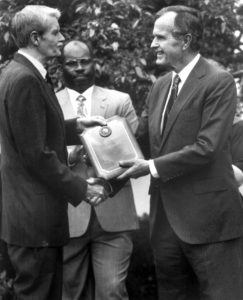
George H.W. Bush the 41st President of the United States who passed away on November 30th played an important role in the early years of the campus safety movement. He signed the original 1990 Campus Security Act (now the Jeanne Clery Act) and 1992’s Campus Sexual Assault Victims’ Bill of Rights into law, and issued the first National Campus Crime and Security Awareness Week proclamation in 1991.
Bush wasn’t originally a backer of these initiatives, but that quickly changed after he met Connie and Howard Clery, who were championing them after the 1986 on-campus murder of their daughter Jeanne, and their attorney Frank Carrington. Presidential historian Doug Wead who served as a Special Assistant to President Bush arranged an introduction and opportunity for them to share their story. “They blurted and he changed his position within days,” Wead wrote of the encounter in 2007.
When they next met, during a Rose Garden ceremony observing National Crime Victims’ Rights Week on April 25, 1990, Bush offered the Clerys high praise for their work and presented them with an award for “outstanding contributions in assisting victims of crime”. “It’s good to see Howard and Connie Clery again,” Bush said. “Howard and Connie embody the power of voluntarism…, and the power of a just cause”.
President Bush signed the Crime Awareness and Campus Security Act of 1990 (Title II of Public Law 101-542) into law on November 8, 1990. This law, now named the Jeanne Clery Disclosure of Campus Security Policy and Campus Crime Statistics Act in memory of the student who inspired it, for the first time required the uniform national disclosure of campus crime statistics and summaries of security policies by institutions of higher education.

Issuing a proclamation on August 22, 1991 recognizing “National Campus Crime and Security Awareness Week, 1991” Bush discussed the importance of the Campus Security Act. “Last year, the Congress passed the ‘Student Right-to-Know and Campus Security Act,’ which requires colleges and universities to inform students and employees about campus crime statistics and campus security policies,” Bush said. “By working together to achieve the goals set forth in this legislation, we will not only promote the safety of those who study and work at our Nation’s institutions of higher learning but also provide our students with a valuable lesson in civic responsibility.”
The Clerys’ non-profit Security On Campus, Inc. (now the Clery Center) quickly recognized the significant challenge of campus sexual violence, and working with their Counsel Frank Carrington they proposed the first national legislation, as an amendment to the Campus Security Act, to address it. President Bush signed this legislation the Campus Sexual Assault Victims’ Bill of Rights into law as a part of the Higher Education Amendments of 1992 (Public Law 102-325, section 486[c]) in July of 1992.
President Bush’s early support of the campus safety movement was critical in giving these efforts the momentum they needed to move forward. Safer campuses and the ongoing process of working to increase campus safety are an important part of his legacy worth remembering.
